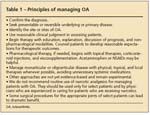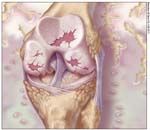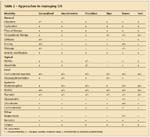Article
Current Approaches to Pain Management for Patients With Osteoarthritis
"Doctor, I'm so relieved to see you," the patient said. "The nurse practitioner told me I have osteoarthritis (OA) all over. I hurt terribly.
ABSTRACT: By using a principle- and evidence-based approach to treatment of patients with osteoarthritis (OA) pain, physicians can improve patients’ function and comfort and reduce their pain and disability. The principles of care include confirming the diagnosis, seeking preventable or reversible underlying or primary disease, identifying the site or sites of OA, and using reasonable clinical judgment in assessing patients. Begin therapy with patient education, explanation, discussion of prognosis, and nonpharmacological modalities. Pharmacological therapy begins with acetaminophen. Whenever possible, manage monarticular or oligoarticular disease with topical or local therapies, avoiding unnecessary systemic medications. Primary OA affects a typical distribution of joints; OA of other joints should alert the physician to a possible secondary OA. Most patients can be helped. (J Musculoskel Med. 2011;28:391-396)
_______________________________________________________________________________________________
Principles of Care
General Approaches
Approaches for Specific Joints
Summary
"Doctor, I'm so relieved to see you," the patient said. "The nurse practitioner told me I have osteoarthritis (OA) all over. I hurt terribly. I tried Tylenol and Advil, but they didn't help. Some of my friends with similar problems have told me they had newer treatments, like Lyrica, Neurontin, Cymbalta, Ultram, and Savella, as well as herbal medications, ginger, massage, fish oils, yoga, electromagnetic field therapy, spas, glucosamine, chrondroitin, acupuncture, tidal irrigation, marijuana, patches, ointments, Duragesic, joint injections, and operations-after they had extensive MRI and other testing-and swear by the results. I'm confused and don't know what to do. Please help! I'm so desperate!"
Treatment of patients with OA pain can be challenging but is rewarding, because they can be helped, sometimes dramatically. By using a principle- and evidence-based approach, physicians can improve patients' function and comfort and reduce their pain and disability. Their lives are restored, at least in part, and that is enormously satisfying.
By clinical definition, OA includes painful symptoms. Therefore, all approaches to management-from the simplest to the most aggressive-are designed to benefit patients. Used properly, they are inextricably linked and are part of an effective therapeutic regimen.
This principle- and evidence-based approach has been effective for most patients, providing comfort, reducing disability, and improving quality of life. The occasional patients who do not respond reasonably well to such a comprehensive therapeutic regimen may benefit from referral to more expert consultants.
In this article, we describe the principles of caring for patients with painful OA. We discuss approaches to patients with "pain all over" and approaches to pain management in specific joints.
TABLE 1

Principles of managing OA
PRINCIPLES OF CARE
Goals of therapy include the restoration and preservation of patients' physical independence by providing symptomatic relief and maintaining quality of life and function. The ultimate goals are to halt disease progression (have “disease-modifying” therapy for OA), reverse established disease, achieve “cures,” and prevent disease. However, the current therapies, although usually helpful, are only palliative. Thus, the basic principles for managing OA pain (Table 1) are as follows:
• Confirm the diagnosis. Do not miss calcium pyrophosphate dihydrate crystal deposition disease, inflammatory arthritis, erosive/inflammatory OA, polymyalgia rheumatica (PMR), fibromyalgia syndrome (FMS) (alone or superimposed), associated depression, neurological or vascular disease, endocrinological disease (thyroid or parathyroid), chronic pain syndromes (eg, complex regional pain syndrome), tendinitis/bursitis (do not confuse epicondylitis with elbow disease, de Quervain tenosynovitis with wrist arthritis, anserine bursitis with knee arthritis, or trochanteric bursitis with hip disease), ochronosis, or hemochromatosis. When in doubt, obtain expert consultation.
• Seek preventable or reversible underlying or primary disease.
FIGURE

The basic principles for managing osteoarthritis (OA) pain include identifying the disease site or sites. Disease may be "generalized" but often is localized to specific joints. As in other joints, local heat, physical measures, and topical therapies may be beneficial for knee OA.
• Identify the site or sites of OA. Disease may be “generalized” but often is localized to specific joints, such as the distal interphalangeal (DIP), first metacarpophalangeal (MCP), first carpometacarpophalangeal (CMC), axial skeleton, hip, knee (Figure), and first metatarsophalangeal (MTP) joints.
• Use reasonable clinical judgment in assessing patients. Experienced clinicians usually recognize OA readily without obtaining extensive diagnostic studies. Plain x-ray films usually are sufficient to identify anatomical abnormalities. Serological studies usually are not necessary, and they may simply introduce confusion-rheumatoid arthritis, systemic lupus erythematosus, and other rheumatologic disorders may be excluded with a thoughtful, thorough, informed clinical evaluation without laboratory testing.
• Begin therapy with patient education, explanation, discussion of prognosis, and nonpharmacological modalities. Many patients feel relieved to learn that their disease is not necessarily rapidly progressive or destructive. Patients can benefit from various nonpharmacological strategies.
Because obesity is a risk factor for the development and progression of OA, patients should be counseled on weight loss. Exercise programs should be tailored to individual patients.
Attention to footwear, gait, and ambulation may result in symptomatic improvement. Patients should be educated about the proper use of walking aids because they may help reduce hip and knee OA pain.
Useful adjuncts to management include help with activities of daily living, activity modification, quadriceps strengthening exercises, patellar taping, and formal programs of occupational and physical therapy. Some patients cope better and some symptoms may be minimized with cognitive-behavioral therapy or formal counseling.
• Pharmacological therapy, if needed, begins with acetaminophen (up to 4 g/d). NSAIDs also are beneficial but should be used at the lowest effective dose. The advantage of acetaminophen over NSAIDs is its safety profile. Because NSAIDs have been associated with GI and renal adverse effects, they should be used with caution in patients who have underlying cardiovascular, renal, or GI disease. The response to a specific NSAID differs from one patient to another.
Cyclooxygenase (COX)-2 inhibitors, such as celecoxib, may be preferable for patients who have a history of GI ulcers, are receiving anticoagulation therapy, or have a bleeding diathesis. NSAIDs may be added as clinically indicated for younger patients and perhaps patients who do not have comorbid medical problems, are also taking corticosteroids or anticoagulants, and did not have previous ulcer disease or GI bleeding. To prevent GI adverse effects, a COX-2 selective inhibitor or a nonselective NSAID together with misoprostol or a proton pump inhibitor may be prescribed. We also might prescribe a nonacetylated salicylate (disalicylate, choline magnesium trisalicylate).
For persistently symptomatic joints for which injections are feasible, intra-articular corticosteroids or hyaluronan may be considered. If there is persistent pain, tramadol also should be considered. This regimen should provide satisfactory symptomatic relief for most patients with OA. Additional pharmacological treatments include some topical medications (capsaicin cream and diclofenac patch or ointment) that also may be quite useful for specific painful or tender areas.
• Whenever possible, manage monarticular or oligoarticular disease with topical or local therapies or both, avoiding unnecessary systemic medications.
• Other approaches to treatment that have been suggested to provide benefit include acupuncture, pregabalin, gabapentin, milnacipran, and duloxetine. Many clinicians now consider glucosamine and chondroitin to have no important clinical value, but they are generally safe and well-tolerated and some patients do report benefit. In our opinion, there is insufficient evidence to support nonexperimental use of tidal lavage, platelet-rich plasma therapy, or herbal and other complementary and alternative medicines for patients with OA.
• We do not recommend routine or long-term use of narcotic analgesics for managing patients with OA. Although these medications are effective for pain management, they should be used rarely and only in patients who are refractory to other pharmacological treatments. Narcotic analgesics should be prescribed by physicians who are experienced in caring for persons receiving these agents.
• Some surgical procedures for appropriate joints in select patients can result in dramatic benefit.
GENERAL APPROACHES
How to approach patients with "pain all over"?
OA should not cause diffuse, nonlocalized pain; patients who complain of this should be assessed for other or associated conditions. For patients with OA, the symptoms should be correlated with disease in specified joints.
For example, widespread pain may reflect FMS; PMR; other arthopathies or rheumatologic disease; endocrinological or metabolic disorders; neuropathy; vascular disease; central sensitization syndrome; or OA of the shoulders, knees, hips, or axial skeleton, and there also might be bursitis or tendinitis. A careful evaluation can clarify this. When sites with OA are identified and specific symptoms are related to them, rational and individualized therapeutic approaches can be developed that are most likely to be successful, and the ordering of expensive and extensive imaging studies and then prescribing something such as Tylenol #3 can be avoided.
OA can affect multiple joints, especially the DIP joints, proximal interphalangeal (PIP) joints, CMC joints, MTP joints, cervical and lumbar spine facet joints, knees, and hips. Many patients who have OA of the DIP or PIP joints may have physical abnormalities that are asymptomatic. A few patients may have “inflammatory” OA, usually of the hands, with an elevated erythrocyte sedimentation rate or C-reactive protein level. They may benefit from hydroxychloroquine or NSAIDs.
How to approach patients with localized or oligoarticular OA?
These patients may be treated initially with nonmedicinal approaches, such as physical therapy and local heat therapy. They also may derive benefit from topical therapies, alternatives to oral NSAIDs that include diclofenac gel and diclofenac patch. Lidocaine patches and topical menthol- and capsaicin-based creams also may provide relief, albeit temporary.
TABLE 2

Approaches to managing OA
Local injection with corticosteroids may be used for patients who have severe pain in 1 or 2 joints. The goal is to provide short-term, temporary relief of OA pain; this usually does not provide long-lasting, permanent relief. Injection of hyaluronic acid into affected joints also may be beneficial for select patients. Patients who do not respond to these may benefit from systemic medical therapies. Acetaminophen may provide symptomatic relief for patients who have OA pain (Table 2).
APPROACHES FOR SPECIFIC JOINTS
Primary OA affects a typical distribution of joints, such as the cervical spine or lumbar spine. OA of other joints should alert the physician to a possible secondary OA.
Hands/wrists. Although PIP and DIP OA can be unsightly, it usually is asymptomatic and may not cause discomfort, pain, or disability. Conservative therapy with local heat or paraffin baths or topical therapies may provide pain relief. Local corticosteroid injections can reduce pain but may be difficult without ultrasonographic guidance to ensure proper localization. Seldom would a patient require joint fusion surgery for severe pain at the PIP or DIP joints. Acetaminophen or NSAID therapy or both may also provide temporary relief, especially when the joints are symptomatic.
The first CMC joint may be problematic because it is used in grasping and pinching and for almost every activity that involves the hand. Patients often lose strength in their fingers and may need assistive devices to complete their activities of daily living. A custom splint worn at nighttime can ease the pain. Local corticosteroid injections usually are of limited benefit. The potential for surgical intervention is limited by the need to use this joint in everyday life.
Shoulders. Primary OA of the shoulder does not occur often. Degenerative changes of the glenohumeral joint should prompt the physician to consider that OA may be the result of another cause (eg, trauma, previous infection, neuropathy or radiculopathy, crystal deposition disease). If corticosteroid injections are ineffective or contraindicated, hyaluronic acid injections may be beneficial for glenohumeral joint arthritis. Ultrasonographic guidance is recommended.
Hips. OA of the hip causes pain and disability for many patients. Corticosteroid and hyaluronic acid injections may be of benefit. When conservative, physical, systemic, and injection therapies are ineffective, surgical intervention with total hip arthroplasty should be considered.
Knees. Knee OA is a common problem. As in other joints, local heat, physical measures, and topical therapies may be beneficial.
We recommend quadriceps strengthening and range of motion exercises, although their value has been questioned. Glucosamine may be only slightly beneficial to patients who have mild knee OA. Corticosteroid and hyaluronic acid injections may provide temporary relief for patients who have contraindications to surgical intervention.
Attention to lower extremity biomechanics is important. Some patients are helped by assisted ambulation, orthoses, and braces. Surgery is indicated when pain becomes severe and diminished function and quality of life become unacceptable to the patient. Radiographic changes associated with knee OA usually are not good indicators for the necessity of surgery; however, when these changes are associated with refractory pain disability, surgical intervention should be considered. Total knee arthroplasty usually is preferable to arthroscopic and partial knee arthroplasties for knee OA.
Feet. OA of the feet usually involves the first MTP joint and presents as a bunion or hallux valgus. This condition can be exacerbated in patients who wear narrow or high-heeled shoes. Wide-fitting shoes or orthoses help reduce the valgus deformity, which may reduce pain. Surgery is indicated when recommended therapeutic measures prove to be ineffective.
Neck/back. The principles of care outlined above apply to OA of the axial skeleton. See the “Bibliography” for more information.
SUMMARY
We counsel patients with OA to have reasonable expectations, and we express confidence that we have therapies that will improve their lives. For patients who have one or a few joints involved, we try largely physical, topical, and injection therapies, sparing them systemic medications. For those who are still symptomatic or have multiple-joint involvement, we include systemic therapy. Most patients can be helped. A few may need referral for more expert consultation.
Problems/comments about this article? Please send feedback.
References:
Bibliography
• Altman RD, Hochberg MC, Moskowitz RW, Schnitzer TJ. American College of Rheumatology Subcommittee on Osteoarthritis Guidelines: Recommendations for the Medical Management of Osteoarthritis of the Hip and Knee. American College of Rheumatology. Atlanta. 2000. http://www.rheumatology.org/practice/clinical/guidelines/oa-mgmt.asp. Accessed September 8, 2011.
• Anandacoomarasamy A, March L. Current evidence for osteoarthritis treatments. Ther Adv Musculoskeletal Dis. 2010;2:17-28.
• Bhangle S, Sen D, Mihailescu V, et al. Potential new therapies for osteoarthritis: a critical assessment. J Musculoskel Med. 2008;25(suppl):S15-S23.
• Bhangle S, Sapru S, Panush RS. Back pain made simple: an approach based on principles and evidence. Cleve Clin J Med. 2009;76:393-399.
• Bijlsma JW, Berenbaum F, Lafeber FP. Osteoarthritis: an update with relevance for clinical practice. Lancet. 2011;377:2115-2126.
• Bryant LR, des Rosier KF, Carpenter MT. Hydroxychloroquine in the treatment of erosive osteoarthritis. J Rheumatol. 1995;22:1527-1531.
• Jordan KM, Arden NK, Doherty M, et al; Standing Committee for International Clinical Studies Including Therapeutic Trials ESCISIT. EULAR recommendations 2003; an evidence based approach to the management of knee osteoarthritis: report of a Task Force of the Standing Committee for International Clinical Studies Including Therapeutic Trials (ESCISIT). Ann Rheum Dis. 2003;62:1145-1155.
• Mandl L. Treating the pain of osteoarthritis-where do we go from here? J Rheumatol. 2011;38:1535-1537.
• Mease PJ, Hanna S, Frakes EP, Altman RD. Pain mechanisms in osteoarthritis: understanding the role of central pain and current approaches to its treatment. J Rheumatol. 2011;38:1546-1551.
• Punzi L, Bertazzolo N, Pianon M, et al. Soluble interleukin 2 receptors and treatment with hydroxychloroquine in erosive osteoarthritis. J Rheumatol. 1996;23:1477-1478.
• Schnitzer TJ. Update on guidelines for the treatment of chronic musculoskeletal pain. Clin Rheumatol. 2006;25(suppl 1):S22-S29.
• Sullivan MD, Bentley S, Fan MY, Gardner G. A single-blind, placebo run-in study of duloxetine for activity-limiting osteoarthritis pain. J Pain. 2009;10:208-213.
• Vista ES, Lau CS. What about supplements for osteoarthritis? A critical and evidenced-based review. Int J Rheum Dis. 2011;14:152-158.
• Zhang W, Doherty M, Arden N, et al; EULAR Standing Committee for International Clinical Studies Including Therapeutics (ESCISIT). EULAR evidence based recommendations for the management of hip osteoarthritis: report of a Task Force of the EULAR Standing Committee for International Clinical Studies Including Therapeutics (ESCISIT). Ann Rheum Dis. 2005;64:669-681.
• Zhang W, Doherty M, Leeb BF, et al. EULAR evidence based recommendations for the management of hand osteoarthritis: report of a Task Force of the EULAR Standing Committee for International Clinical Studies Including Therapeutics (ESCISIT). Ann Rheum Dis. 2007;66:377-388.
• Zhang W, Moskowitz RW, Nuki G, et al. OARSI recommendations for the management of hip and knee osteoarthritis, part II: OARSI evidence-based, expert consensus guidelines. Osteoarthritis Cartilage. 2008;16:137-162.




